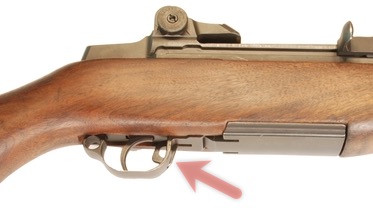Trump's "cocked and loaded": A tangled history
Language Log 2019-06-22
….On Monday they shot down an unmanned drone flying in International Waters. We were cocked & loaded to retaliate last night on 3 different sights when I asked, how many will die. 150 people, sir, was the answer from a General. 10 minutes before the strike I stopped it, not….
— Donald J. Trump (@realDonaldTrump) June 21, 2019
Rather than "cocked and loaded", the usual idiom is "locked and loaded", for which the OED gives the following definition, with citations going back to 1940:
to lock and load: (a) to prepare a firearm for firing by pulling back and 'locking' the bolt and loading the ammunition (frequently in imperative, as an order); (b) figurative to ready oneself for action or confrontation.
1940 N.Y. Times 19 Nov. 12/3 Lieut. Col. Joseph T. Hart, range officer, boomed through his microphone, 'Lock and Load'.
President Trump got a predictable amount of grief for this apparent malapropism — e.g. Greg Evans, "Cocked & Loaded: Twitter Takes Aim At Trump Phrase; Andrew Dice Clay Might Hold Clue", Deadline 6/21/2019:
"Cocked and Loaded" is a) the name of Andrew Dice Clay's breakthrough 1992 tour, the one for which he wore his soon-to-be-signature huge-collared leather jacket; b) a 2006 album by the industrial metal band Revolting Cocks; c) a malaprop for the actual military phrase "lock and load"; and d) the latest Twitter fodder all but gift-wrapped by President Donald Trump for pundits, comics and pickers of low-hanging social media fruit.
Or e) all of the above. Ding ding ding.
This morning, Trump used the bizarre, probably mistaken, certainly mangled, wording in a series of tweets that attempted to explain his last-second decision to halt an air strike against Iran in retaliation for shooting down one of our drones this week.
In fact the idiom's history was both lexically and mechanically tangled before the president intervened. Working backwards from the OED's 1940 citation:
Anthony Leviero, "Men of 27th Hail the Garand Rifle After Its First Use on the Range", NYT 11/19/1940:
The first impression was of the safety factor. Last Thursday, when the correspondent made the first of three trips to the range, Lieut. Col.Joseph T. Hart, range officer, boomed through his microphone, "Lock and Load." That seemed a slip of the tongue. It had always been "load and lock" with the Springfield, the soldier pushing in his clip of five cartridges and snapping the safety catch.
Sergeant David Paye of Company A quickly pointed out to a Garand novice the safety catch cut into the trigger guard of this rifle, which puts the firing pin out of operation before the cartridges go in. At the moment of fire it is released by a forward push of the trigger finger.

So the M1903 Springfield rifle's "load" (the clip) and then "lock" the safety turned into the Garand M1's "lock" (the safety) and then "load" the clip. When I went through basic training in 1969, the range instructions for the M14 were still "lock and load", for similar reasons — although I recall vaguely associating the "lock" part with pulling the operating rod back so as to be able to load a magazine. For later (and more confusing) developments, see Mark Keefe, "Lock Then Load", American Rifleman 19/15/2012.
But the range instructions for the M1903 Springfield rifle already involved a shift of meaning for both lock and load, but especially lock. The OED explains that "In use with reference to firearms … the name [lock] is due to the construction of the wheel-lock firing mechanism, which used the same parts as a contemporary fastening mechanism operated with a key. This sense development is paralleled in etymologically unrelated words meaning 'lock' in other languages (e.g. Dutch slot (1562 in vuurslot firelock; compare slot n.1) and Swedish lås (1548 with reference to firearms))."
Wikipedia lists many types of lock in antique firearms — "matchlock, wheellock, snaplock, snaphance, miquelet lock, doglock, flintlock, modern caplock/percussion cap, …"
Wiktionary finds an example of the phrase "locked and loaded" from 1793, and an example of "loaded and locked" from 1815, both in reference to flintlock weapons. The 1815 reference is to Walter Scott's Guy Mannering:
Bertram, in complaisance, eat a morsel or two; and Dinmont, whose appetite was unabated either by wonder, apprehension, or the meal of the morning, made his usual figure as a trencherman. She then offered each a single glass of spirits, which Bertram drank diluted, and his companion plain.
'Will ye taste naething yoursell, Luckie?' said Dinmont.
'I shall not need it,' replied their mysterious hostess. 'And now,' she said, 'ye maun hae arms: ye maunna gang on dry-handed; but use them not rashly. Take captive, but save life; let the law hae its ain. He maun speak ere he die.'
'Who is to be taken? who is to speak?' said Bertram, in astonishment, receiving a pair of pistols which she offered him, and which, upon examining, he found loaded and locked.
'The flints are gude,' she said, 'and the powder dry; I ken this wark weel.'
Then, without answering his questions, she armed Dinmont also with a large pistol, and desired them to choose sticks for themselves out of a parcel of very suspicious-looking bludgeons which she brought from a corner. Bertram took a stout sapling, and Dandie selected a club which might have served Hercules himself. They then left the hut together, and in doing so Bertram took an opportunity to whisper to Dinmont, 'There's something inexplicable in all this. But we need not use these arms unless we see necessity and lawful occasion; take care to do as you see me do.'